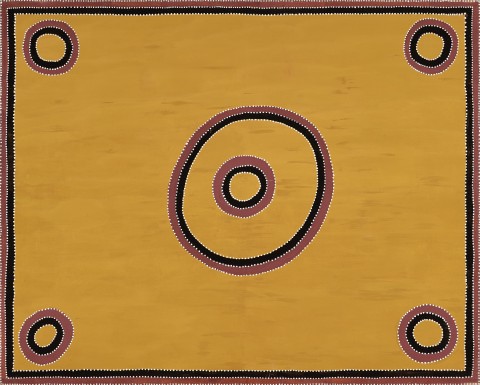BARRAGOO (LAKE GREGORY), 1996
ROVER THOMAS (JOOLAMA)
natural earth pigments and synthetic binder on canvas
160.0 x 200.0 cm
bears inscription verso: artist’s name, size and Waringarri Aboriginal Arts cat. AP0785
Waringarri Aboriginal Arts, Kununurra, Western Australia
Chapman Gallery, Canberra
Private collection, Sydney, acquired from the above in 1997
Celebrated as one of Australia’s most distinguished artists, Rover Thomas did not pick up the paintbrush until he was in his mid-50s, after an arduous career as a stockman which took him and his family across Western Australia and the Northern Territory. He began painting on a regular basis and within a decade his prolific creativity was widely recognised, leading to his selection, alongside Trevor Nickolls, as one of the first indigenous artists to represent Australia at the Venice Biennale in 1990.1 Solo exhibitions and awards followed, with major art institutions and private collectors quick to acquire his works.
Thomas is widely credited as the founder of the East Kimberley style of painting, in which spacious plains of textured ochre depict the landscape in aerial perspective. Incorporating the traditions of rock painting, white dots serve to create emphasis, drawing the eye along forms of the land in which important cultural events are encoded. Thomas’ extensive travels and intense awareness of the land informed his art and his use of local earth pigments grounded them with a deep connection to his country.
This painting depicts Lake Gregory – known now by its Walmajarri name, Paruku – located where the Tanami Desert and the Great Sandy Desert merge in Western Australia. A vast desert lake teeming with life and a haven for waterbirds, it is represented as a large circle in the centre of the canvas with the surrounding circles indicating nearby waterholes. Outlined in white dots and set against a background of rich yellow ochre, Barragoo (Lake Gregory) is a large-scale work, consistent with Thomas’ minimalist composition style and restrained colour palette. Thomas painted the lake several times in his lifetime, encountering it first as a young man travelling up the Canning Stock Route from the desert country.
Now declared as an Indigenous Protected Area (IPA), Lake Gregory is a site of spiritual significance and enduring home to the Walmajarri traditional owners. They believe that it was formed during the Dreamtime, whereby the ancestral hero Kiki, a star from the east, fell from the sky and landing in the lake, became a man who would go on to create life.2 The lake is also home to the Billiluna Rainbow Snake who, according to the accompanying Waringarri Arts certificate, was dangerous and responsible for a man’s drowning. Through this work, Thomas pays homage to an ancient landscape and its ceremonial stories that continue to inspire.
1. Thomas, R. with Akerman, K., Macha, M., Christensen, W. and Caruana, W., Roads Cross: The paintings of Rover Thomas, National Gallery of Australia, Canberra, 1994, p. 3
2. Morton, S., Martin, M., Mahood, K., Carty, J., Desert Lake: Art, Science and Stories from Paruku, CSIRO Publishing, 2012, p. 8
DIANA McPHILLIPS
